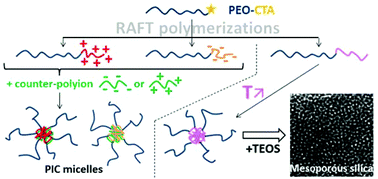Asymmetric neutral, cationic and anionic PEO-based double-hydrophilic block copolymers (DHBCs): synthesis and reversible micellization triggered by temperature or pH†
Abstract
The syntheses of three poly(ethylene oxide)-based (PEO) double-hydrophilic block copolymers (DHBCs) of different second block nature (thermosensitive poly(N-isopropylacrylamide) (PNIPAM) block, anionic poly(vinylbenzyl phosphonic di-acid) block, and cationic poly(vinylbenzyl triethyl ammonium chloride) block) are described. The synthesis strategy depends on the synthesis of a single 5kD-PEO-based macro-chain transfer agent that is able to control the RAFT polymerizations of various functional monomers. Low molecular weights of the second block were targeted to obtain asymmetric structures for the DHBCs. Their ability to form micelles under appropriate conditions (specified temperature, pH and nature of the auxiliary of micellization) and the reversibility of the micellization process were checked. Finally, a nanostructured hybrid silica material was obtained using the PNIPAM-based copolymer as a structure-directing agent (SDA), which yielded well-organized mesoporous silica after template removal.


 Please wait while we load your content...
Please wait while we load your content...